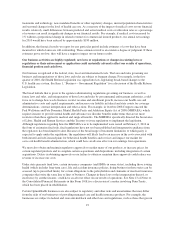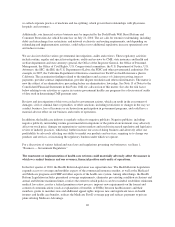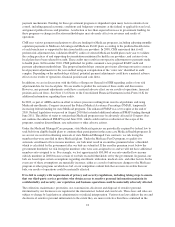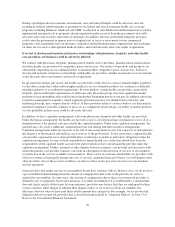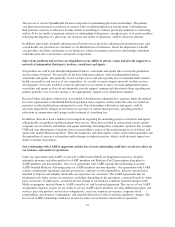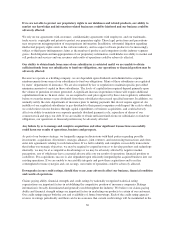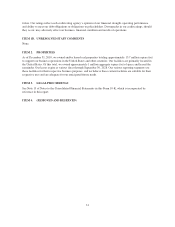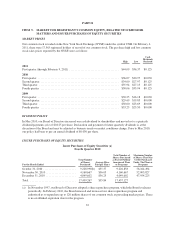United Healthcare 2010 Annual Report Download - page 24
Download and view the complete annual report
Please find page 24 of the 2010 United Healthcare annual report below. You can navigate through the pages in the report by either clicking on the pages listed below, or by using the keyword search tool below to find specific information within the annual report.amended provisions or repeal it altogether. Any partial or complete repeal or amendment or implementation
difficulties, or uncertainty regarding such events, could adversely impact our ability to capitalize on the
opportunities presented by the Health Reform Legislation or may cause us to incur additional costs of
compliance. For example, if the individual mandate is declared unconstitutional without corresponding changes
to other provisions of the Health Reform Legislation to protect against the risk of adverse selection (such as
revisions to the guaranteed issue and renewal requirements, prohibition on pre-existing condition exclusions, and
rating restrictions), our financial position and results of operations may be materially adversely affected.
Congress is also considering additional health care reform measures, and a number of state legislatures have
enacted or are contemplating significant reforms of their health insurance markets. The effects of the Health
Reform Legislation and recently adopted state laws, and the regulations that have been and will be promulgated
thereunder, are difficult to predict, and we cannot predict whether any other federal or state proposals will
ultimately become law. Such laws and rules could force us to materially change how we do business, restrict
revenue and enrollment growth in certain products and market segments, restrict premium growth rates for
certain products and market segments, change the nature of our contracted network relationships, increase our
medical and administrative costs and capital requirements, expose us to an increased risk of liability (including
increasing our liability in federal and state courts for coverage determinations and contract interpretation) or put
us at risk for loss of business. In addition, our results of operations, our market share, our financial position,
including our ability to maintain the value of our goodwill, and our cash flows could be materially adversely
affected by such changes.
For additional information regarding the Health Reform Legislation, see Item 1, “Business — Government
Regulation” and Item 7, “Management’s Discussion and Analysis of Financial Condition and Results of
Operations — Executive Overview — Business Trends — Health Care Reforms.”
As a payer in various government health care programs, we are exposed to additional risks associated with
program funding, enrollments, payment adjustments and audits that could adversely affect our revenues,
cash flows and results of operations.
We participate in various federal, state and local government health care coverage programs, including as a payer
in Medicare Advantage, Medicare Part D, various Medicaid programs and CHIP, and receive revenues from
these programs. These programs generally are subject to frequent changes, including changes that may reduce the
number of persons enrolled or eligible, reduce the amount of reimbursement or payment levels, or increase our
administrative or medical costs under such programs. For example, in 2009, CMS implemented a reduction in
Medicare Advantage reimbursements of approximately 5% for 2010, and as part of the Health Reform
Legislation, Medicare Advantage payment rates for 2011 were frozen at 2010 levels. Separately, CMS
implemented a reduction in Medicare Advantage reimbursements of 1.6% for 2011. Beginning in 2012,
additional cuts to Medicare Advantage plans will take effect, with changes being phased-in over two to six years,
depending on the level of payment reduction in a county.
Although we have adjusted members’ benefits and premiums on a selective basis, terminated benefit plans in
certain counties, and intensified both our medical and operating cost management in response to these rate
reductions, there can be no assurance that we will be able to execute successfully on these or other strategies to
address changes in the Medicare Advantage program. As part of the Health Reform Legislation, CMS has
developed a system whereby plans that meet certain quality ratings will be entitled to various quality bonus
payments, and there can be no assurance that our plans will meet these quality ratings. Our results of operations,
financial position and cash flows could be materially adversely affected by funding reductions, or if our plans do
not meet the requirements to receive quality bonus payments.
Our participation in the Medicare Advantage, Medicare Part D, and various Medicaid and CHIP programs occurs
through bids that are submitted periodically. Revenues for these programs are dependent upon periodic funding
from the federal government or applicable state governments and allocation of the funding through various
22









